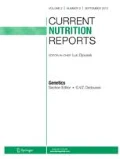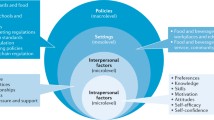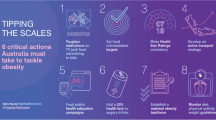Abstract
Poor diet is one of the leading contributors to the burden of disease globally. Reducing the portion size of commonly purchased food and beverages has been identified as a promising approach for reducing obesity and related non-communicable diseases across populations. To date, there have been few population-level interventions developed with the aim of addressing portion size. Of those that have been developed, the majority have been at the discretion of food manufacturers to implement, and there is very little evidence to indicate that these interventions have resulted in any meaningful changes. There is nevertheless substantial opportunity for future public health actions targeting portion size, including government-led targets for portion size reduction in key food categories; portion size caps on unhealthy foods in selected settings, such as schools and hospitals; the standardization of declared portion sizes across food categories; and restrictions on the use of price incentives that encourage purchase of larger portion sizes.
Similar content being viewed by others
References
Papers of particular interest, published recently, have been highlighted as: • Of importance •• Of major importance
Swinburn BA, Sacks G, Hall KD, McPherson K, Finegood DT, Moodie ML, et al. The global obesity pandemic: shaped by global drivers and local environments. Lancet. 2011;378(9793):804–14.
Crino M, Sacks G, Vandevijvere S, Swinburn B, Neal B. The influence on population weight gain and obesity of the macronutrient composition and energy density of the food supply. Curr Obes Rep. 2015;4(1):1–10.
World Health Organisation. Global status report on noncommunicable diseases 20102011.
World Cancer Research Fund. WCRF international food policy framework for health diets: NOURISHING—improving nutritional quality of the whole food supply 2014 June 2014. Available from: http://www.wcrf.org/policy_public_affairs/nourishing_framework/food_supply)composition_reformulation.
Swinburn B, Sacks G, Vandevijvere S, Kumanyika S, Lobstein T, Neal B, et al. INFORMAS (International Network for Food and Obesity/non‐communicable diseases Research, Monitoring and Action Support): overview and key principles. Obes Rev. 2013;14(S1):1–12.
Downs SM, Thow AM, Leeder SR. The effectiveness of policies for reducing dietary trans fat: a systematic review of the evidence. Bull World Health Organ. 2013;91(4):262-9h.
Bibbins-Domingo K, Chertow GM, Coxson PG, Moran A, Lightwood JM, Pletcher MJ, et al. Projected effect of dietary salt reductions on future cardiovascular disease. N Engl J Med. 2010;362(7):590–9.
He F, MacGregor G. A comprehensive review on salt and health and current experience of worldwide salt reduction programmes. J Hum Hypertens. 2009;23(6):363–84.
He FJ, MacGregor GA. Salt reduction lowers cardiovascular risk: meta-analysis of outcome trials. Lancet. 2011;378(9789):380–2.
National Heart Foundation of Australia. Rapid review of the evidence: effectiveness of food reformulation as a strategy to improve population health. 2012.
He FJ, Pombo-Rodrigues S, MacGregor GA. Salt reduction in England from 2003 to 2011: its relationship to blood pressure, stroke and ischaemic heart disease mortality. BMJ Open. 2014;4(4), e004549.
Fogelholm M, Anderssen S, Gunnarsdottir I, Lahti-Koski M. Dietary macronutrients and food consumption as determinants of long-term weight change in adult populations: a systematic literature review. Food Nutr Res. 2012;56:10.3402/fnr.v56i0.19103.
Matthiessen J, Fagt S, Biltoft-Jensen A, Beck AM, Ovesen L. Size makes a difference. Public Health Nutr. 2003;6(01):65–72.
Sacks FM, Bray GA, Carey VJ, Smith SR, Ryan DH, Anton SD, et al. Comparison of weight-loss diets with different compositions of fat, protein, and carbohydrates. N Engl J Med. 2009;360(9):859–73.
Vernarelli JA, Mitchell DC, Hartman TJ, Rolls BJ. Dietary energy density is associated with body weight status and vegetable intake in U.S. children. J Nutr. 2011;141(12):2204–10.
Livingstone MBE, Pourshahidi LK. Portion size and obesity. Adv Nutr: Int Rev J. 2014;5(6):829–34.
Young LR, Nestle M. The contribution of expanding portion sizes to the US obesity epidemic. Am J Public Health. 2002;92(2):246–9.
Piernas C, Popkin BM. Food portion patterns and trends among U.S. children and the relationship to total eating occasion size, 1977–2006. J Nutr. 2011;141(6):1159–64.
Nielsen SJ, Popkin BM. Patterns and trends in food portion sizes, 1977–1998. JAMA. 2003;289(4):450–3.
Smiciklas-Wright H, Mitchell DC, Mickle SJ, Goldman JD, Cook A. Foods commonly eaten in the United States, 1989–1991 and 1994–1996: are portion sizes changing? J Am Diet Assoc. 2003;103(1):41–7.
Zlatevska N, Dubelaar C, Holden SS. Sizing up the effect of portion size on consumption: a meta-analytic review. J Mark. 2014;78(3):140–54.
Vermeer WM, Steenhuis IHM, Poelman MP. Small, medium, large or supersize? The development and evaluation of interventions targeted at portion size. Int J Obes. 2014;38(S1):S13–8.
Faulkner GP, Pourshahidi LK, Wallace JMW, Kerr MA, McCrorie TA, Livingstone MBE. Serving size guidance for consumers: is it effective? Proc Nutr Soc. 2012;71(04):610–21.
Hollands GJ, Shemilt I, Marteau TM, Jebb SA, Lewis HB, Wei Y, et al. Portion, package or tableware size for changing selection and consumption of food, alcohol and tobacco. The Cochrane Library. 2015. This comprehensive systematic review and meta-analysis is of great importance to public health. Findings from this analysis help to pinpoint key areas for the development of public health initiatives when addressing the obesity and non-communicable disease epidemic.
Diliberti N, Bordi PL, Conklin MT, Roe LS, Rolls BJ. Increased portion size leads to increased energy intake in a restaurant meal. Obes Res. 2004;12(3):562–8.
Wansink B, Kim J. Bad popcorn in big buckets: portion size can influence intake as much as taste. J Nutr Educ Behav. 2005;37(5):242–5.
Rolls BJ, Roe LS, Meengs JS, Wall DE. Increasing the portion size of a sandwich increases energy intake. J Am Diet Assoc. 2004;104(3):367–72.
Vermeer WM, Steenhuis IHM, Seidell JC. Portion size: a qualitative study of consumers’ attitudes toward point-of-purchase interventions aimed at portion size. Health Educ Res. 2010;25(1):109–20.
Small L, Lane H, Vaughan L, Melnyk B, McBurnett D. A systematic review of the evidence: the effects of portion size manipulation with children and portion education/training interventions on dietary intake with adults. Worldviews Evid-Based Nurs. 2013;10(2):69–81.
Byrd‐Bredbenner C, Schwartz J. The effect of practical portion size measurement aids on the accuracy of portion size estimates made by young adults. J Hum Nutr Diet. 2004;17(4):351–7.
Ayala GX. An experimental evaluation of a group-versus computer-based intervention to improve food portion size estimation skills. Health Educ Res. 2006;21(1):133–45.
Riley WT, Beasley J, Sowell A, Behar A. Effects of a Web-based food portion training program on food portion estimation. J Nutr Educ Behav. 2007;39(2):70–6.
Brindal E, Wilson C, Mohr P, Wittert G. Perceptions of portion size and energy content: implications for strategies to affect behaviour change. Public Health Nutr. 2012;15(02):246–53.
Mozaffarian D, Afshin A, Benowitz NL, Bittner V, Daniels SR, Franch HA, et al. Population approaches to improve diet, physical activity, and smoking habits a scientific statement from the American Heart Association. Circulation. 2012;126(12):1514–63.
NSW Department of Health, Training NDoEa. Fresh Tastes @ School: NSW Health School Canteen Strategy 2004 August 2015. Available from: https://www.det.nsw.edu.au/policies/student_serv/student_health/canteen_gu/pd02_58V2_school_canteen.pdf.
Australian Capital Territory Government. Policy: Healthy Food and Drink Choices. 2013. Available from: http://www.health.act.gov.au/sites/default/files/Healthy%20Food%20and%20Drink%20Choices%20Policy.pdf.
Queensland Government. Smart Choices: Healthy Food and Drink Supply Strategy for Queensland Schools. 2016. Available from: http://education.qld.gov.au/schools/healthy/docs/smart-choices-strategy.pdf.
South Australian Government. Health Food and Drink Choices for Staff and Visitors in SA Health Facilities. 2011. Available from: http://www.sahealth.sa.gov.au/wps/wcm/connect/5d68ac80465eee648649fe2e504170d4/HealthyFoodDrinkChoices-PHCS-HPB-1103.pdf?MOD=AJPERES&CACHEID=5d68ac80465eee648649fe2e504170d4.
Victorian Government. School Canteens and Other School Food Services Policy. 2013. Available from: http://www.education.vic.gov.au/school/principals/management/Pages/canteenpolicy.aspx.
Western Australian Government. Healthy food and drink policy, healthy food and drink procedures. 2014. Available from: http://det.wa.edu.au/policies/detcms/policy-planning-and-accountability/policies-framework/policies/healthy-food-and-drink-policy.en?cat-id=3457102
Cullen KW, Thompson DI. Texas school food policy changes related to middle school a la carte/snack bar foods: potential savings in kilocalories. J Am Diet Assoc. 2005;105(12):1952–4.
Wang YC, Vine SM. Caloric effect of a 16-ounce (473-mL) portion-size cap on sugar-sweetened beverages served in restaurants. Am J Clin Nutr. 2013:ajcn. 054833.
Ray A. Bye-bye Big Gulp—New York City’s attempt to limit the sale of soda. Stetson L Rev. 2014;44:265.
Pomeranz JL, Brownell KD. Can government regulate portion sizes? N Engl J Med. 2014;371(21):1956.
Yoong SL, Nathan NK, Wyse RJ, Preece SJ, Williams CM, Sutherland RL, et al. Assessment of the school nutrition environment: a study in Australian primary school canteens. Am J Prev Med. 2015;49(2):215–22.
de Silva‐Sanigorski A, Breheny T, Jones L, Lacy K, Kremer P, Carpenter L, et al. Government food service policies and guidelines do not create healthy school canteens. Aust N Z J Public Health. 2011;35(2):117–21.
Ardzejewska K, Tadros R, Baxter D. A descriptive study on the barriers and facilitators to implementation of the NSW (Australia) healthy school canteen strategy. Health Educ J. 2013;72(2):136–45.
Woods J, Bressan A, Langelaan C, Mallon A, Palermo C. Australian school canteens: menu guideline adherence or avoidance? Health Promot J Austr. 2014;25(2):110–5.
Hills A, Nathan N, Robinson K, Fox D, Wolfenden L. Improvement in primary school adherence to the NSW healthy school canteen strategy in 2007 and 2010. Health Promot J Austr. 2015;26(2):89–92.
Nanney MS, Davey CS, Kubik MY. Rural disparities in the distribution of policies that support healthy eating in US secondary schools. J Acad Nutr Diet. 2013;113(8):1062–8.
Ramsay S, Safaii S, Croschere T, Branen LJ, Wiest M. Kindergarteners’ entrée intake increases when served a larger entrée portion in school lunch: a quasi-experiment. J Sch Health. 2013;83(4):239–42.
Williams CM, Nathan N, Delaney T, Yoong SL, Wiggers J, Preece S, et al. CAFÉ: a multicomponent audit and feedback intervention to improve implementation of healthy food policy in primary school canteens: protocol of a randomised controlled trial. BMJ Open. 2015;5(6), e006969.
Hartstein J, Cullen KW, Reynolds KD, Harrell J, Resnicow K, Kennel P. Impact of portion-size control for school a la carte items: changes in kilocalories and macronutrients purchased by middle school students. J Am Diet Assoc. 2008;108(1):140–4.
Marcello K. The New York City sugar-sweetened beverage portion cap rule: lawfully regulating public enemy number one in the obesity epidemic. Conn Law Rev. 2013;46:807.
Browne MN, Clapp KB, Kubasek NK, Biksacky L. Protecting consumers from themselves: consumer law and the vulnerable consumer. Drake Law Rev. 2015;63:157.
Mello MM, Studdert DM. Making the case for health‐enhancing laws after Bloomberg. Hastings Cent Rep. 2014;44(1):8.
Marteau TM, Hollands GJ, Shemilt I, Jebb SA. Downsizing: policy options to reduce portion sizes to help tackle obesity. BMJ. 2015;351:h5863. This comprehensive review draws upon the findings of the Cochrane review by Hollands et al. (2015) and provides suggestions for effective portion size initiatives to reduce obesity.
Jebb SA. The public health responsibility deal food network. Nutr Bull. 2012;37(4):355–8.
Knai C, Petticrew M, Durand MA, Eastmure E, James L, Mehrotra A, et al. Has a public–private partnership resulted in action on healthier diets in England? An analysis of the public health responsibility deal food pledges. Food Policy. 2015;54:1–10.
UK Department of Health. Public Health Responsibility Deal—Food Network: Calorie Reduction Pledge Development Tool. 2014 August 2015. Available from: https://responsibilitydeal.dh.gov.uk/wp-content/uploads/2014/04/calorie-reduction-development-tool-final-v3.pdf
Healthy Weight Commitment Foundation. Food and beverage manufacturers pledging to reduce annual calories by 1.5 trillion by 2015. [Available from: www.healthyweightcommit.org/news/Reduce_Annual_Calories/.
Ng SW, Slining MM, Popkin BM. The healthy weight commitment foundation pledge: calories sold from US consumer packaged goods, 2007–2012. Am J Prev Med. 2014;47(4):508–19.
Department of Health. The Food and Health Dialogue: Portion Sizing. 2012 February 2015. Available from: http://www.foodhealthdialogue.gov.au/internet/foodandhealth/publishing.nsf/COntent/portion-sizing.
Australian Government Department of Health. Healthy Food Partnership Website. Available from: http://www.health.gov.au/internet/main/publishing.nsf/Content/Healthy-Food-Partnership-Home.
Australian Food and Grocery Council. Healthier Australia commitment: food and beverage innovation—aiming to improve the health of Australian families. 2012 February 2015. Available from: http://togethercounts.com.au/wp-content/uploads/2013/HAC-Food-Targets.pdf.
Dallas SK, Liu PJ, Ubel PA. Potential problems with increasing serving sizes on the nutrition facts label. Appetite. 2015;95:577–84.
Versluis I, Papies EK, Marchiori D. Preventing the pack size effect: exploring the effectiveness of pictorial and non-pictorial serving size recommendations. Appetite. 2015;87:116–26.
Lando AM, Lo SC. Single-larger-portion-size and dual-column nutrition labeling may help consumers make more healthful food choices. J Acad Nutr Diet. 2013;113(2):241–50.
Grunert KG, Fernández-Celemín L, Wills JM, Genannt Bonsmann SS, Nureeva L. Use and understanding of nutrition information on food labels in six European countries. J Public Health. 2010;18(3):261–77.
Grunert KG, Wills JM. A review of European research on consumer response to nutrition information on food labels. J Public Health. 2007;15(5):385–99.
Grunert KG, Wills JM, Fernández-Celemín L. Nutrition knowledge, and use and understanding of nutrition information on food labels among consumers in the UK. Appetite. 2010;55(2):177–89.
Baltas G. Nutrition labelling: issues and policies. Eur J Mark. 2001;35(5/6):708–21.
Cowburn G, Stockley L. Consumer understanding and use of nutrition labelling: a systematic review. Public Health Nutr. 2005;8(01):21–8.
Byrd-Bredbenner C, Wong A, Cottee P. Consumer understanding of US and EU nutrition labels. Br Food J. 2000;102(8):615–29.
Hersey JC, Wohlgenant KC, Arsenault JE, Kosa KM, Muth MK. Effects of front-of-package and shelf nutrition labeling systems on consumers. Nutr Rev. 2013;71(1):1–14.
Antonuk B, Block LG. The effect of single serving versus entire package nutritional information on consumption norms and actual consumption of a snack food. J Nutr Educ Behav. 2006;38(6):365–70.
Food Standards Australia New Zealand. Nutrition information: user guide to standard 1.2.8—nutrition information requirements. 2013.
Roberto C, Khandpur N. Improving the design of nutrition labels to promote healthier food choices and reasonable portion sizes. Int J Obes. 2014;38:S25–33.
Haskelberg H, Neal B, Dunford E, Flood V, Rangan A, Thomas B, et al. High variation in manufacturer-declared serving size of packaged discretionary foods in Australia. Br J Nutr. 2016;115(10):1810–8.
Trieu K, Neal B, Hawkes C, Dunford E, Campbell N, Rodriguez-Fernandez R, et al. Salt reduction initiatives around the world—a systematic review of progress towards the global target. PLoS One. 2015;10(7), e0130247.
He FJ, Brinsden HC, MacGregor GA. Salt reduction in the United Kingdom: a successful experiment in public health. J Hum Hypertens. 2014;28(6):345–52.
Elliott T, Trevena H, Sacks G, Dunford E, Martin J, Webster J, et al. A systematic interim assessment of the Australian Government’s Food and Health Dialogue. Med J Aust. 2014;200:92–5.
Wyness LA, Butriss JL, Stanner SA. Reducing the population’s sodium intake: the UK Food Standards Agency’s salt reduction programme. Public Health Nutr. 2012;15(02):254–61.
Webster JL, Dunford EK, Hawkes C, Neal BC. Salt reduction initiatives around the world. J Hypertens. 2011;29(6):1043–50.
Niebylski ML, Lu T, Campbell NRC, Arcand J, Schermel A, Hua D, et al. Healthy food procurement policies and their impact. Int J Environ Res Public Health. 2014;11(3):2608–27.
Mohr GS, Lichtenstein DR, Janiszewski C. The effect of marketer-suggested serving size on consumer responses: the unintended consequences of consumer attention to calorie information. J Mark. 2012;76(1):59–75.
Vermeer WM, Alting E, Steenhuis IH, Seidell JC. Value for money or making the healthy choice: the impact of proportional pricing on consumers’ portion size choices. Eur J Pub Health. 2010;20(1):65–9.
Harnack LJ, French SA, Oakes JM, Story MT, Jeffery RW, Rydell SA. Effects of calorie labeling and value size pricing on fast food meal choices: results from an experimental trial. Int J Behav Nutr Phys Act. 2008;5(1):1.
Haws KL, Liu PJ. Half-size me? How calorie and price information influence ordering on restaurant menus with both half and full entrée portion sizes. Appetite. 2016;97:127–37.
Hawkes C, Smith TG, Jewell J, Wardle J, Hammond RA, Friel S, et al. Smart food policies for obesity prevention. Lancet. 2015;385(9985):2410–21. This paper uses evidence to draw upon and provide insight as to how food policies work and are developed, and in turn how these policies can be adapted for effective obesity prevention.
Petrescu DC, Hollands GJ, Couturier D-L, Ng Y-L, Marteau TM. Public acceptability in the UK and USA of nudging to reduce obesity: the example of reducing sugar-sweetened beverages consumption. PLoS One. 2016;11(6), e0155995.
Bole K. UCSF launches healthy beverage initiative: health sciences campus will focus sales on zero-calorie and nutritious drinks. 2015 Accessed 30 August 2016. Available from: http://www.ucsf.edu/news/2015/05/129901/ucsf-launches-health-beverage-initiative.
Cancer Council Victoria. Rethink sugary drink. 2014. Available from: http://www.rethinksugarydrink.org.au/about.
NSW Government. Make healthy normal. 2015. Available from: https://www.makehealthynormal.nsw.gov.au/.
Food and Drug Administration. Food serving sizes getting a reality check. 2015 May 2015. Available from: http://www.fda.gov/ForConsumers/COnsumerUpdates/ucm386203.htm.
CODEX Alimentarious Commission. Codex Alimentarious: Food Labelling 5th Edition2007. Available from: ftp://ftp.fao.org/docrep/fao/010/a1390e/a1390e00.pdf.
Acknowledgments
The authors are researchers within a NHMRC Centre for Research Excellence in Obesity Policy and Food Systems (APP1041020). Gary Sacks is the recipient of an Australian Research Council Discovery Early Career Researcher Award (DE160100307).
Author information
Authors and Affiliations
Corresponding author
Ethics declarations
Conflict of Interest
Michelle Crino interacts regularly on a non-financial basis with multiple large corporations in the Food Processing Industry and the Quick Service Restaurant industry in Australia and overseas as a part of her work to improve the quality of the food supply.
Gary Sacks declares that he has no conflict of interest.
Jason H. Y. Wu declares that he has no conflict of interest.
Human and Animal Rights and Informed Consent
This article does not contain any studies with human or animal subjects performed by any of the authors.
Additional information
Michelle Crino, Gary Sacks, and Jason H. Y. Wu are researchers within a NHMRC Centre for Research Excellence in Obesity Policy and Food Systems (APP1041020).
Gary Sacks is the recipient of an Australian Research Council Discovery Early Career Researcher Award (DE160100307)
This article is part of the Topical Collection on Cardiovascular Disease
Rights and permissions
About this article
Cite this article
Crino, M., Sacks, G. & Wu, J.H.Y. A Review of Population-Level Actions Targeting Reductions in Food Portion Sizes to Address Obesity and Related Non-communicable Diseases. Curr Nutr Rep 5, 323–332 (2016). https://doi.org/10.1007/s13668-016-0181-7
Published:
Issue Date:
DOI: https://doi.org/10.1007/s13668-016-0181-7




